Tech
Donald Trump says he wants all future bitcoin to be mined in the U.S.
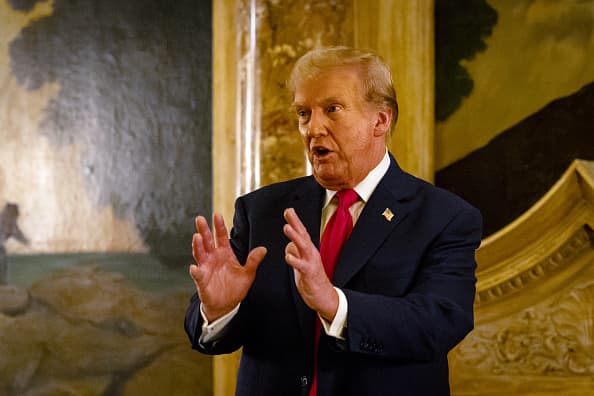
- Donald Trump says he wants all future bitcoin to be minted in the U.S.
- The proclamation comes after the former president convened a working group of the country’s top bitcoin miners on Tuesday in Mar-a-Lago.
- The coalition included representatives from Riot Platforms, Marathon Digital Holdings, Terawulf, CleanSpark, Core Scientific, Arkon Energy, Cholla Energy and Exacore.
Former U.S. President Donald Trump speaks at a dinner at Mar-a-Lago on June 5, 2024 in West Palm Beach, Florida. Now that his criminal trial in New York has wrapped up, the former president has scheduled a number of fundraising events around the country to aid his presidential bid. (Photo by Eva Marie Uzcategui/Getty Images)
Eva Marie Uzcategui | Getty Images
This past Tuesday night in Palm Beach, Florida, about a dozen bitcoin mining executives and experts sat down with former president Donald Trump for an hour and a half in a small tea room at the Mar-a-Lago Club. As a steady drizzle fell outside, they sipped from Trump-branded water bottles and tried to sell him on the world’s largest cryptocurrency by market capitalization.
The meeting marked the first time the former president and presumptive Republican presidential nominee — recently convicted of 34 felonies in New York — had taken a meeting with the technologists securing the $1.3 trillion bitcoin network.
The intimate gathering brought together a coalition of some of the biggest private and public American miners in the business, including representatives from Riot Platforms, Marathon Digital Holdings, Terawulf, CleanSpark, Core Scientific, Arkon Energy, Cholla Energy and Exacore.
CNBC spoke to half the miners who attended the closed door session on Tuesday, including the CEO of Riot Platforms. Jason Les told CNBC that one of the group’s top talking points was the fact that the U.S. is number one in a lot of things, and it should be number one at bitcoin, especially as the world’s top coin touches new all-time price highs this year. Bitcoin is up 160% to around $67,000 since June 2023.
Senator Bill Hagerty (R-Tenn.) — who is the ranking member on the Senate’s Banking Committee and Finance Subcommittee, as well as a vocal proponent of the digital asset industry broadly, and bitcoin mining in particular — was also there to help guide what participants described as a free-flowing and wide-ranging discussion on bitcoin, energy, job creation and the push to beat China in the artificial intelligence arms race.
Many agreed that the former president was collaborative, had well-informed questions and seemed genuinely interested in how bitcoin miners could help solve America’s energy deficit problem.
BTC Inc. CEO David Bailey, who organized the mining sit-down with Trump, says that the meeting is part of a larger push to support the former president’s bid to return to the White House.
“Our industry intends to make bitcoin and crypto a defining issue for the 2024 election,” Bailey said of the effort. “As an industry we are committed to raising over $100 million and turning out more than 5,000,000 voters for the Trump reelection effort.”
Less than four hours after Trump’s roundtable wrapped, the former president took to social media to extol the virtues of the bitcoin mining business.
“Bitcoin mining may be our last line of defense against a CBDC,” Trump posted shortly before midnight on Tuesday.
“Biden’s hatred of Bitcoin only helps China, Russia, and the Radical Communist Left. We want all the remaining Bitcoin to be MADE IN THE USA!!! It will help us be ENERGY DOMINANT!!!”
Bitcoin and some other cryptocurrencies are created through a process known as proof-of-work, in which miners around the world run high-powered computers that collectively validate transactions and simultaneously create new tokens.
The process requires heaps of electricity, leading miners to seek out the cheapest sources of power. Many have begun to set up shop in the U.S. in the last few years, much to the chagrin of a mix of mostly Democratic lawmakers, including Sen. Elizabeth Warren (D-Mass.).
“It’s such an easy issue for politicians,” in part because there is “no major ask that we have to change the rules or anything else,” Les, who runs a bitcoin mining company with a market cap of about $3 billion, told CNBC.
“We just want to be treated like everyone else,” Les added, noting that more than one in four people in the U.S. now owns bitcoin, according to a survey recently conducted by bitcoin financial services firm Unchained.
For months, Trump — who recently launched his latest non-fungible token collection on the solana blockchain in April — has been making increasingly bullish comments on crypto.
He is now accepting digital currency donations and has pledged to defend the rights of those who choose to self-custody their coins, meaning that they don’t rely on a centralized entity like Coinbase to hold their tokens and instead, do it themselves in personal crypto wallets, which are sometimes outside the reach of the Internal Revenue Service. Trump also vowed at the Libertarian National Convention in Washington in May to keep Sen. Warren and “her goons” away from bitcoin holders.
In early June in San Francisco, technologists, crypto executives, and venture capitalists paid up to $300,000 per ticket to join a Trump fundraiser that ultimately raised more than $12 million.
And then on Tuesday, Trump declared that all future bitcoin will be minted in the U.S., should he return to the White House.
Geoff Kendrick, who heads up digital assets research at Standard Chartered, recently wrote that he expects bitcoin to reach the $100,000 price threshold as the U.S. approaches the November presidential election and $150,000 by the end of the year if Trump wins.
Read more about tech and crypto from CNBC Pro
Decentralization is a key feature of bitcoin, because it means the network isn’t controlled by any entity and can’t be shut down — even if a government disapproves. Roughly 37% of the bitcoin network’s miners are located in the U.S., with China closely following at 21% of bitcoin’s global processing power despite Beijing banning the practice in 2021.
“He wants to keep all of the remaining bitcoin mining in the U.S. and out of China,” Matthew Schultz, CleanSpark’s executive chairman and director, who attended the Mar-a-Lago working group, told CNBC. “For him to be legitimately engaged in the bitcoin industry, and understanding the way that mining works, was really awesome.“
The group also touched on doing more to support U.S.-made ASICs, short for Application-Specific Integrated Circuits, which are the purpose-built rigs used to mine bitcoin. Most ASICs are built in China, but Auradine is a U.S.-based startup that is manufacturing this equipment.
Jayson Browder, senior vice president of Government Affairs at Marathon Digital Holdings, said that he brought one of these machines to show Trump to highlight the significance of “bringing chips manufacturing back to the U.S.”
The emphasis on protectionist policies that safeguard domestic manufacturing echoes the former president’s “America First” economic agenda.
Trump also expressed concern over the U.S. launching a central bank digital currency, or CBDC — that is, a digital coin issued by the Federal Reserve that could grant the government greater access to personal spending data.
Bitcoin is seen by many in the industry as the antithesis of a CBDC because it is a censorship-resistant and borderless currency that is not centrally issued, nor constrained by geographic or governmental boundaries. Trump wrote that bitcoin mining may be the “last line of defense against a CBDC.”
When asked about the Tuesday evening meeting, Brian Hughes, senior advisor to the Trump administration, told CNBC that “crypto innovators and others in the technology sector are under attack from Biden and Democrats” and that “while Biden stifles innovation with more regulation and higher taxes, President Trump is ready to encourage American leadership in this and other emerging technologies.”
Trump’s pro-crypto campaign platform comes as polling data shows that crypto matters more to the voting public now than in past presidential elections. A Harris poll funded by the spot bitcoin ETF issuer Grayscale found that one in three U.S. voters will consider a candidate’s crypto stance before casting a ballot.
Bitcoin has also seen its place as an asset class solidified in the traditional financial markets through the adoption of spot bitcoin exchange-traded funds. Since launching in January in the U.S., these funds have collectively brought in roughly $60 billion in assets under management as institutions and an entirely new set of investors gain exposure to the digital asset class for the first time.
So far this year, crypto-friendly venture capital firm Andreessen Horowitz; centralized crypto exchange Coinbase; veteran venture capitalist Ron Conway; venture capital executive Fred Wilson; tech executives Cameron and Tyler Winklevoss; and Ripple, a crypto solutions business, have all donated tens of millions of dollars to Fairshake, according to the pro-crypto super PAC.
Meanwhile, bitcoin miners who met with Trump this week tell CNBC they have been trying and failing for years to get into a room with President Biden. Under the current administration, the U.S. Treasury Department has looked to impose a 30% tax squarely on the cost of electricity used in crypto-related mining operations.
Multiple attendees described the unfettered access to the presumptive Republican nominee to be a welcome change from the status quo.
CNBC reached out to the White House to ask about the administration’s perceived reluctance to engage with bitcoin miners but did not immediately hear back.
“He walked around and shook hands with everyone in the room, talked about where they’re from, and thanked us for being there,” Schultz said of Trump’s demeanor during the meeting on Tuesday night, adding, “He’s smart as a whip. Not one note for that entire interaction.”
It was a no comms and no photographer policy at the mining roundtable on Tuesday.
Attendees, who had an expansive view over thunderstorms on the Atlantic coast that night, forfeited their smartphones to a Radio Frequency Identification pouch that blocked incoming and outgoing signals. As participants lost their sense of time, they convened under a large chandelier listening to the former president actively engage on the nuances of America’s energy deficit, bitcoin mining, and AI — without the aid of a teleprompter — for the duration of the conversation.
“He just really knew his stuff,” said Browder of Marathon.
“We were very impressed by how in the weeds he was on some pretty dense topics when you’re talking about artificial intelligence, data centers, energy buildout, and transmission,” continued Browder, who added that it was the first time bitcoin miners have formally met with the former president to discuss the industry.
CNBC spoke to half a dozen miners who were at the meeting, all of whom converged on the same conclusion; that Trump understood how bitcoin mining complements some of the bigger macro challenges that the U.S. has as a country, most notably the imminent need for the rapid buildout of energy production and transmission infrastructure amid the booming interest in generative AI technologies.
Schultz of the NASDAQ-traded mining firm CleanSpark said Trump came in, sat down, and got right down to business after grabbing a Diet Coke and a cookie from the four-plate spread of macadamia, chocolate chip, and oatmeal varieties adorning the table.
Trump “actually believes that bitcoin provides value,” said CleanSpark’s executive chairman. “I went there feeling like this is going to be a campaign rally; a highly politicized campaign rally.”
“It was anything but a fundraiser pitch,” continued Schultz.
Exacore president Chris Cook echoed that takeaway, telling CNBC that Trump was “very knowledgeable on the subject” of bitcoin mining and that he understood the significance of the job creation that could come from supporting big data mining in the U.S.
“We’re able to train people that have been displaced from industries that may have evolved or no longer exist — and train them to operate and work in a bitcoin mine,” said Cook. “The coal industry, for example. There’s not nearly as many jobs there anymore, and we can teach them to operate a bitcoin mine.”
Amanda Fabiano, a veteran of the mining industry who is on the board of a publicly traded mining firm and the founder of Fabiano Consulting, came away with a similar impression. She says that the former president seemed especially interested in hearing more about the substantial job creation that the mining industry generates in remote parts of the country in sectors ranging from technology to construction, as well as the financial incentive it provides for the buildout of infrastructure to harness the power of stranded renewable energy sources.
Marathon’s Browder says that a lot of the places where they mine bitcoin are in rural areas of the United States that have been left behind, whether it was a town once known for its coal plants, or factories that have shuttered altogether.
“We’ve come in and revitalized those areas, and I think that resonates very well with former President Trump, his team, and obviously, a lot of voters in rural America that support him,” said Browder.
Exacore’s Cook says the kind of job creation they’re talking about extends well beyond staffing a mine. The mining industry justifies the economic investment to create new power generation infrastructure, which then creates the need for thousands of new roles to make that buildout happen.
“That’s where you’ve got all these ancillary jobs; it’s not just the bitcoin mining directly,” said Cook.
“I think we can about double the amount of power generation in the U.S., which would, by my estimate, add two to three percent to GDP and create close to a million jobs,” continued Cook.
“He’s been speaking more about energy independence, jobs, and technology,” Marathon Digital’s Browder said of Trump. “I think it’s the broader context of what’s happening around the world with the power competition between the U.S. and China.”
Across the U.S. are untapped and stranded sources of renewable energy. In West Texas, for example, there is an idyllic overlap of sun quality and wind speed. But a lot of that renewable energy is concentrated in remote parts of the state, and without a financial incentive, there is little reason to build out renewable infrastructure to harness this energy.
Enter bitcoin miners.
Some have opted to build mining sites where wind and solar are abundant and the transmission system is constrained, meaning that power wants to flow down the line, but the lines are full. These mines act like a large power station but in reverse. The mines will absorb abundant renewable energy at times when supply outpaces demand, thereby monetizing these assets when there are no other buyers. And on the flip side, the mines will incrementally ramp down their energy intake, as demand on the grid rises.
Adding bitcoin miners to the portfolio of energy buyers has helped to improve the core economics of renewable power production. Providing demand to these semi-stranded assets essentially makes renewables economically viable when they might not be otherwise.
Schultz noted, however, that Trump isn’t a huge fan of wind energy, because it’s too expensive to build, maintain, and dispose of when the components go bad, so he doesn’t see it as a long-term solution, but he is apparently a fan of renewables otherwise.
“It’s a race against the rest of the world building this infrastructure, so we don’t want the United States to be left behind in this regard,” added Riot’s Les.
Demand for AI compute and infrastructure surged after OpenAI unveiled ChatGPT in November 2022, setting off a rush of investment in AI models and startups.
Data centers alone could use up to 9% of the country’s power by the end of the decade, according to the Electric Power Research Institute. That’s more than double today’s demand across the U.S today.
“When you talk about the grid and energy production, a lot of the conversation was around AI and the amount of energy that’s going to be needed there,” said Marathon’s Browder.
Exacore’s Cook noted that Trump “was very much aware of how much energy AI needs.”
Bitcoin miners do two things especially well.
When miners partner with utility companies, they turn off their data centers almost instantly when there is too much power demand and give energy back. This helps to stabilize the grid, and miners are then compensated for curtailing their consumption.
In some cases, bitcoin miners also make it more cost effective to build the infrastructure necessary to bring renewables onto the grid.
Both those things are important when it comes to building out energy infrastructure across the country.
“These are synergies that I think the Trump administration understands very well in this context of, we need more energy, and there’s a grid power competition between the U.S. and China,” said Marathon’s Browder.
“Those are the high level pieces that I think the Trump administration are thinking about and developing policies around,” added Browder. “They’re very forward thinking.”
In the closed-door meeting, Trump also spoke about the fact that fossil fuels are likely to make a comeback as they are in several other countries, due to the demand for increased energy capacity for data centers around the world.
Tapping into nuclear energy is seen by many as a cleaner alternative and the answer to meeting these ballooning power demands.
Microsoft co-founder Bill Gates and Amazon founder Jeff Bezos have invested in nuclear plants in recent years, as has Sam Altman, who is best known for being the CEO of his $80 billion start-up OpenAI. Altman told CNBC last year that he’s a big believer in nuclear when it comes to serving the needs of AI workloads. He’s also backed two different nuclear power start-ups, one of which just listed on the New York Stock Exchange in May.
“I don’t see a way for us to get there without nuclear,” Altman said. “I mean, maybe we could get there just with solar and storage. But from my vantage point, I feel like this is the most likely and the best way to get there.”
TeraWulf powers its mining sites with nuclear energy, and is looking to get into machine learning.
The company’s chief strategy officer, Kerri Langlais, tells CNBC that whether it’s bitcoin mining or AI, the reliance solely on intermittent renewables, whether it be solar or wind, which are fluctuating, is not going to be enough to support the tremendous projections for the amount of energy that is going to be required to support build out over the next five to ten years.
“We definitely talked about nuclear,” Langlais said of the sit-down with Trump.
“We need to think about that in the context of how we’re operating, how the grid is operating, the role that bitcoin mining plays in that, because we can provide a pretty valuable service to the grid in that sort of fluctuating supply environment.”
— CNBC’s Brian Schwartz contributed to this report.
Tech
Harvard Alumni, Tech Moguls, and Best-Selling Authors Drive Nearly $600 Million in Pre-Order Sales
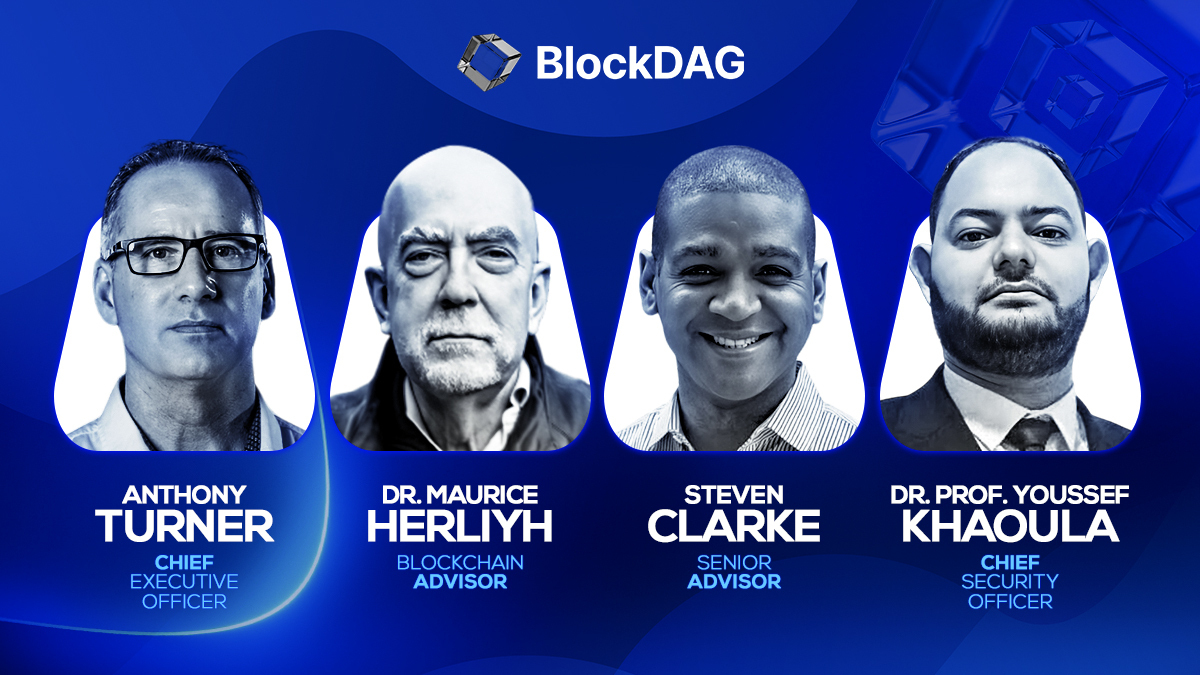
BlockDAG Network’s history is one of innovation, perseverance, and a vision to push the boundaries of blockchain technology. With Harvard alumni, tech moguls, and best-selling authors at the helm, BlockDAG is rewriting the rules of the cryptocurrency game.
CEO Antony Turner, inspired by the successes and shortcomings of Bitcoin and Ethereum, says, “BlockDAG leverages existing technology to push the boundaries of speed, security, and decentralization.” This powerhouse team has led a staggering 1,600% price increase in 20 pre-sale rounds, raising over $63.9 million. The secret? Unparalleled expertise and a bold vision for the future of blockchain.
Let’s dive into BlockDAG’s success story and find out what the future holds for this cryptocurrency.
The Origin: Why BlockDAG Was Created
In a recent interview, BlockDAG CEO Antony Turner perfectly summed up why the market needs BlockDAG’s ongoing revolution. He said:
“The creation of BlockDAG was inspired by Bitcoin and Ethereum, their successes and their shortcomings.
If you look at almost any new technology, it is very rare that the first movers remain at the forefront forever. Later incumbents have a huge advantage in entering a market where the need has been established and the technology is no longer cutting edge.
BlockDAG has done just that: our innovation is incorporating existing technology to provide a better solution, allowing us to push the boundaries of speed, security, and decentralization.”
The Present: How Far Has BlockDAG Come?
BlockDAG’s presale is setting new benchmarks in the cryptocurrency investment landscape. With a stunning 1600% price increase over 20 presale lots, it has already raised over $63.9 million in capital, having sold over 12.43 billion BDAG coins.
This impressive performance underscores the overwhelming confidence of investors in BlockDAG’s vision and leadership. The presale attracted over 20,000 individual investors, with the BlockDAG community growing exponentially by the hour.
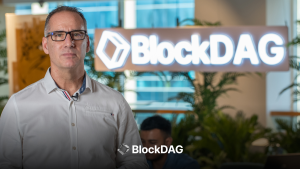
These monumental milestones have been achieved thanks to the unparalleled skills, experience and expertise of BlockDAG’s management team:
Antony Turner – Chief Executive Officer
Antony Turner, CEO of BlockDAG, has over 20 years of experience in the Fintech, EdTech, Travel and Crypto industries. He has held senior roles at SPIRIT Blockchain Capital and co-founded Axona-Analytics and SwissOne. Antony excels in financial modeling, business management and scaling growth companies, with expertise in trading, software, IoT, blockchain and cryptocurrency.
Director of Communications
Youssef Khaoulaj, CSO of BlockDAG, is a Smart Contract Auditor, Metaverse Expert, and Red Team Hacker. He ensures system security and disaster preparedness, and advises senior management on security issues.
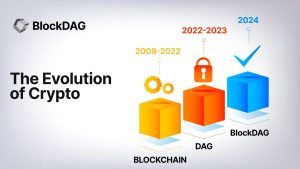
advisory Committee
Steven Clarke-Martin, a technologist and consultant, excels in enterprise technology, startups, and blockchain, with a focus on DAOs and smart contracts. Maurice Herlihy, a Harvard and MIT graduate, is an award-winning computer scientist at Brown University, with experience in distributed computing and consulting roles, most notably at Algorand.
The Future: Becoming the Cryptocurrency with the Highest Market Cap in the World
Given its impressive track record and a team of geniuses working tirelessly behind the scenes, BlockDAG is quickly approaching the $600 million pre-sale milestone. This crypto powerhouse will soon enter the top 30 cryptocurrencies by market cap.
Currently trading at $0.017 per coin, BlockDAG is expected to hit $1 million in the coming months, with the potential to hit $30 per coin by 2030. Early investors have already enjoyed a 1600% ROI by batch 21, fueling a huge amount of excitement around BlockDAG’s presale. The platform is seeing significant whale buying, and demand is so high that batch 21 is almost sold out. The upcoming batch is expected to drive prices even higher.

Invest in BlockDAG Pre-Sale Now:
Pre-sale: https://purchase.blockdag.network
Website: https://blockdag.network
Telegram: https://t.me/blockDAGnetwork
Discord: Italian: https://discord.gg/Q7BxghMVyu
No spam, no lies, just insights. You can unsubscribe at any time.
Tech
How Karak’s Latest Tech Integration Could Make Data Breaches Obsolete

- Space and Time uses zero-knowledge proofs to ensure secure and tamper-proof data processing for smart contracts and enterprises.
- The integration facilitates faster development and deployment of Distributed Secure Services (DSS) on the Karak platform.
Karak, a platform known for its strong security capabilities, is enhancing its Distributed Secure Services (DSS) by integrating Space and Time as a zero-knowledge (ZK) coprocessor. This move is intended to strengthen trustless operations across its network, especially in slashing and rewards mechanisms.
Space and Time is a verifiable processing layer that uses zero-knowledge proofs to ensure that computations on decentralized data warehouses are secure and untampered with. This system enables smart contracts, large language models (LLMs), and enterprises to process data without integrity concerns.
The integration with Karak will enable the platform to use Proof of SQL, a new ZK-proof approach developed by Space and Time, to confirm that SQL query results are accurate and have not been tampered with.
One of the key features of this integration is the enhancement of DSS on Karak. DSS are decentralized services that use re-staked assets to secure the various operations they provide, from simple utilities to complex marketplaces. The addition of Space and Time technology enables faster development and deployment of these services, especially by simplifying slashing logic, which is critical to maintaining security and trust in decentralized networks.
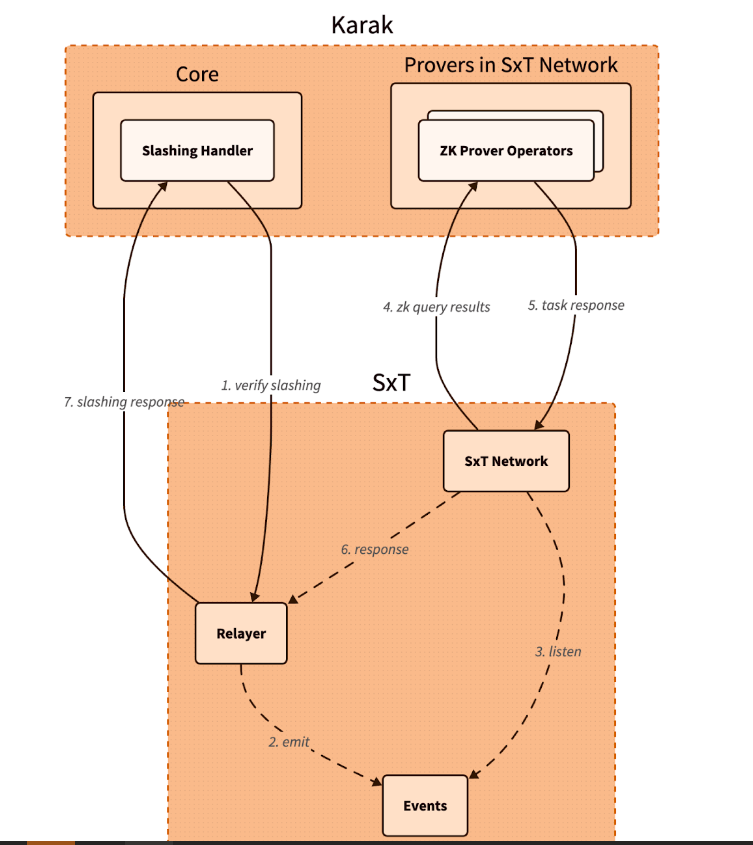
Additionally, Space and Time is developing its own DSS for blockchain data indexing. This service will allow community members to easily participate in the network by running indexing nodes. This is especially beneficial for applications that require high security and decentralization, such as decentralized data indexing.
The integration architecture follows a detailed and secure flow. When a Karak slashing contract needs to verify a SQL query, it calls the Space and Time relayer contract with the required SQL statement. This contract then emits an event with the query details, which is detected by operators in the Space and Time network.
These operators, responsible for indexing and monitoring DSS activities, validate the event and route the work to a verification operator who runs the query and generates the necessary ZK proof.
The result, along with a cryptographic commitment on the queried data, is sent to the relayer contract, which verifies and returns the data to the Karak cutter contract. This end-to-end process ensures that the data used in decision-making, such as determining penalties within the DSS, is accurate and reliable.
Karak’s mission is to provide universal security, but it also extends the capabilities of Space and Time to support multiple DSSs with their data indexing needs. As these technologies evolve, they are set to redefine the secure, decentralized computing landscape, making it more accessible and efficient for developers and enterprises alike. This integration represents a significant step towards a more secure and verifiable digital infrastructure in the blockchain space.
Website | X (Twitter) | Discord | Telegram
No spam, no lies, just insights. You can unsubscribe at any time.
Tech
Cryptocurrency Payments: Should CFOs Consider This Ferrari-Approved Trend?
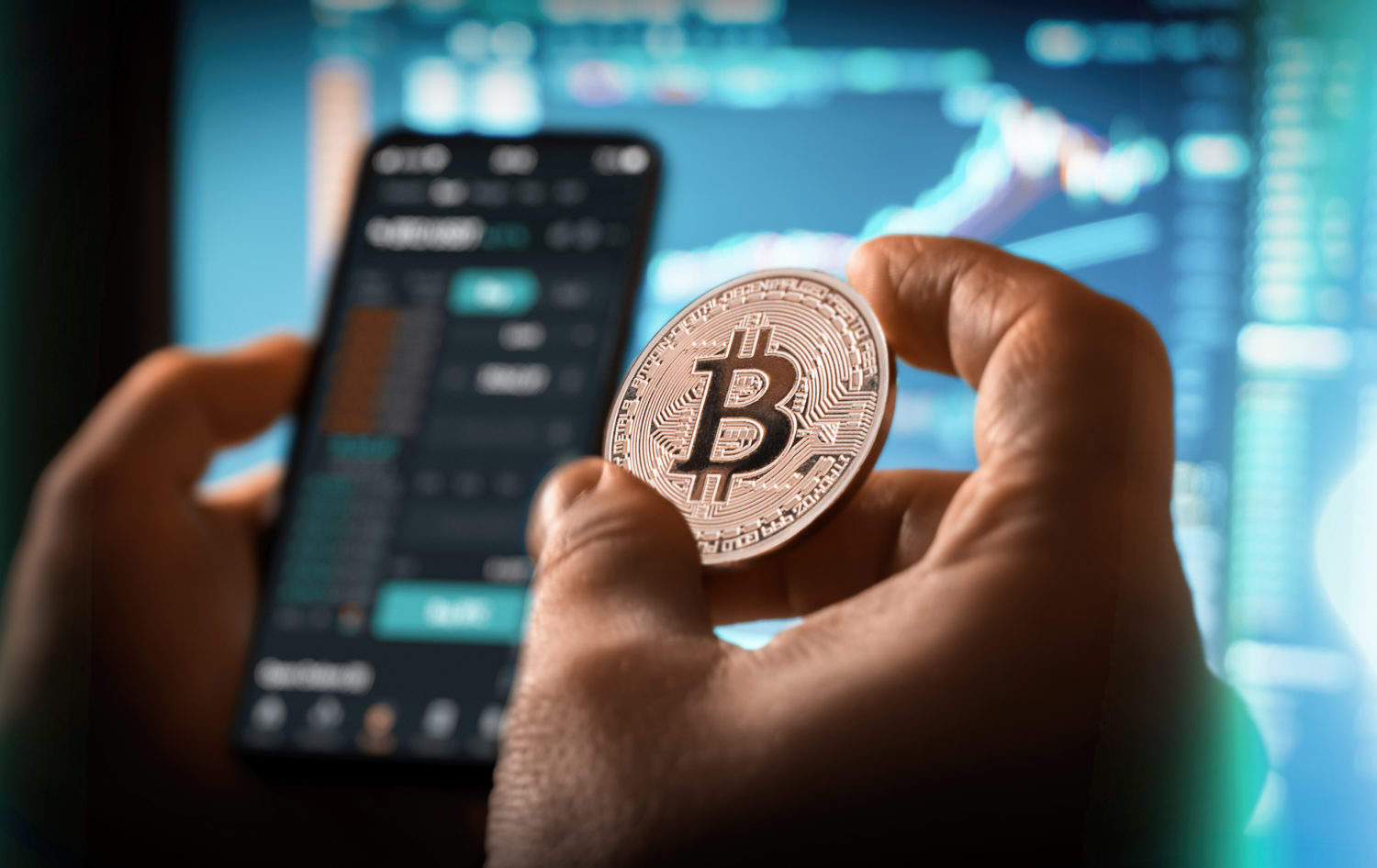
Iconic Italian luxury carmaker Ferrari has announced the expansion of its cryptocurrency payment system to its European dealer network.
The move, which follows a successful launch in North America less than a year ago, raises a crucial question for CFOs across industries: Is it time to consider accepting cryptocurrency as a form of payment for your business?
Ferrari’s move isn’t an isolated one. It’s part of a broader trend of companies embracing digital assets. As of 2024, we’re seeing a growing number of companies, from tech giants to traditional retailers, accepting cryptocurrencies.
This change is determined by several factors:
- Growing mainstream adoption of cryptocurrencies
- Growing demand from tech-savvy and affluent consumers
- Potential for faster and cheaper international transactions
- Desire to project an innovative brand image
Ferrari’s approach is particularly noteworthy. They have partnered with BitPay, a leading cryptocurrency payment processor, to allow customers to purchase vehicles using Bitcoin, Ethereum, and USDC. This satisfies their tech-savvy and affluent customer base, many of whom have large digital asset holdings.
Navigating Opportunities and Challenges
Ferrari’s adoption of cryptocurrency payments illustrates several key opportunities for companies considering this move. First, it opens the door to new customer segments. By accepting cryptocurrency, Ferrari is targeting a younger, tech-savvy demographic—people who have embraced digital assets and see them as a legitimate form of value exchange. This strategy allows the company to connect with a new generation of affluent customers who may prefer to conduct high-value transactions in cryptocurrency.
Second, cryptocurrency adoption increases global reach. International payments, which can be complex and time-consuming with traditional methods, become significantly easier with cryptocurrency transactions. This can be especially beneficial for businesses that operate in multiple countries or deal with international customers, as it potentially reduces friction in cross-border transactions.
Third, accepting cryptocurrency positions a company as innovative and forward-thinking. In today’s fast-paced business environment, being seen as an early adopter of emerging technologies can significantly boost a brand’s image. Ferrari’s move sends a clear message that they are at the forefront of financial innovation, which can appeal to customers who value cutting-edge approaches.
Finally, there is the potential for cost savings. Traditional payment methods, especially for international transactions, often incur substantial fees. Cryptocurrency transactions, on the other hand, can offer lower transaction costs. For high-value purchases, such as luxury cars, these savings could be significant for both the business and the customer.
While the opportunities are enticing, accepting cryptocurrency payments also presents significant challenges that businesses must address. The most notable of these is volatility. Cryptocurrency values can fluctuate dramatically, sometimes within hours, posing potential risk to businesses that accept them as payment. Ferrari addressed this challenge by implementing a system that instantly converts cryptocurrency received into traditional fiat currencies, effectively mitigating the risk of value fluctuations.
Regulatory uncertainty is another major concern. The legal landscape surrounding cryptocurrencies is still evolving in many jurisdictions around the world. This lack of clear and consistent regulations can create compliance challenges for companies, especially those operating internationally. Companies must remain vigilant and adaptable as new laws and regulations emerge, which can be a resource-intensive process.
Implementation costs are also a significant obstacle. Integrating cryptocurrency payment systems often requires substantial investment in new technology infrastructure and extensive staff training. This can be especially challenging for small businesses or those with limited IT resources. The costs are not just financial; a significant investment of time is also required to ensure smooth implementation and operation.
Finally, security concerns loom large in the world of cryptocurrency transactions. While blockchain technology offers some security benefits, cryptocurrency transactions still require robust cybersecurity measures to protect against fraud, hacks, and other malicious activity. Businesses must invest in robust security protocols and stay up-to-date on the latest threats and protections, adding another layer of complexity and potential costs to accepting cryptocurrency payments.
Strategic Considerations for CFOs
If you’re thinking of following in Ferrari’s footsteps, here are the key factors to consider:
- Risk Assessment: Carefully evaluate potential risks to your business, including financial, regulatory, and reputational risks.
- Market Analysis: Evaluate whether your customer base is significantly interested in using cryptocurrencies for payments.
- Technology Infrastructure: Determine the costs and complexities of implementing a cryptographic payment system that integrates with existing financial processes.
- Regulatory Compliance: Ensure that cryptocurrency acceptance is in line with local regulations in all markets you operate in. Ferrari’s gradual rollout demonstrates the importance of this consideration.
- Financial Impact: Analyze how accepting cryptocurrency could impact your cash flow, accounting practices, and financial reporting.
- Partnership Evaluation: Consider partnering with established crypto payment processors to reduce risk and simplify implementation.
- Employee Training: Plan comprehensive training to ensure your team is equipped to handle cryptocurrency transactions and answer customer questions.
While Ferrari’s adoption of cryptocurrency payments is exciting, it’s important to consider this trend carefully.
A CFO’s decision to adopt cryptocurrency as a means of payment should be based on a thorough analysis of your company’s specific needs, risk tolerance, and strategic goals. Cryptocurrency payments may not be right for every business, but for some, they could provide a competitive advantage in an increasingly digital marketplace.
Remember that the landscape is rapidly evolving. Stay informed about regulatory changes, technological advancements, and changing consumer preferences. Whether you decide to accelerate your crypto engines now or wait in the pit, keeping this payment option on your radar is critical to navigating the future of business transactions.
Was this article helpful?
Yes No
Sign up to receive your daily business insights
Tech
Bitcoin Tumbles as Crypto Market Selloff Mirrors Tech Stocks’ Plunge
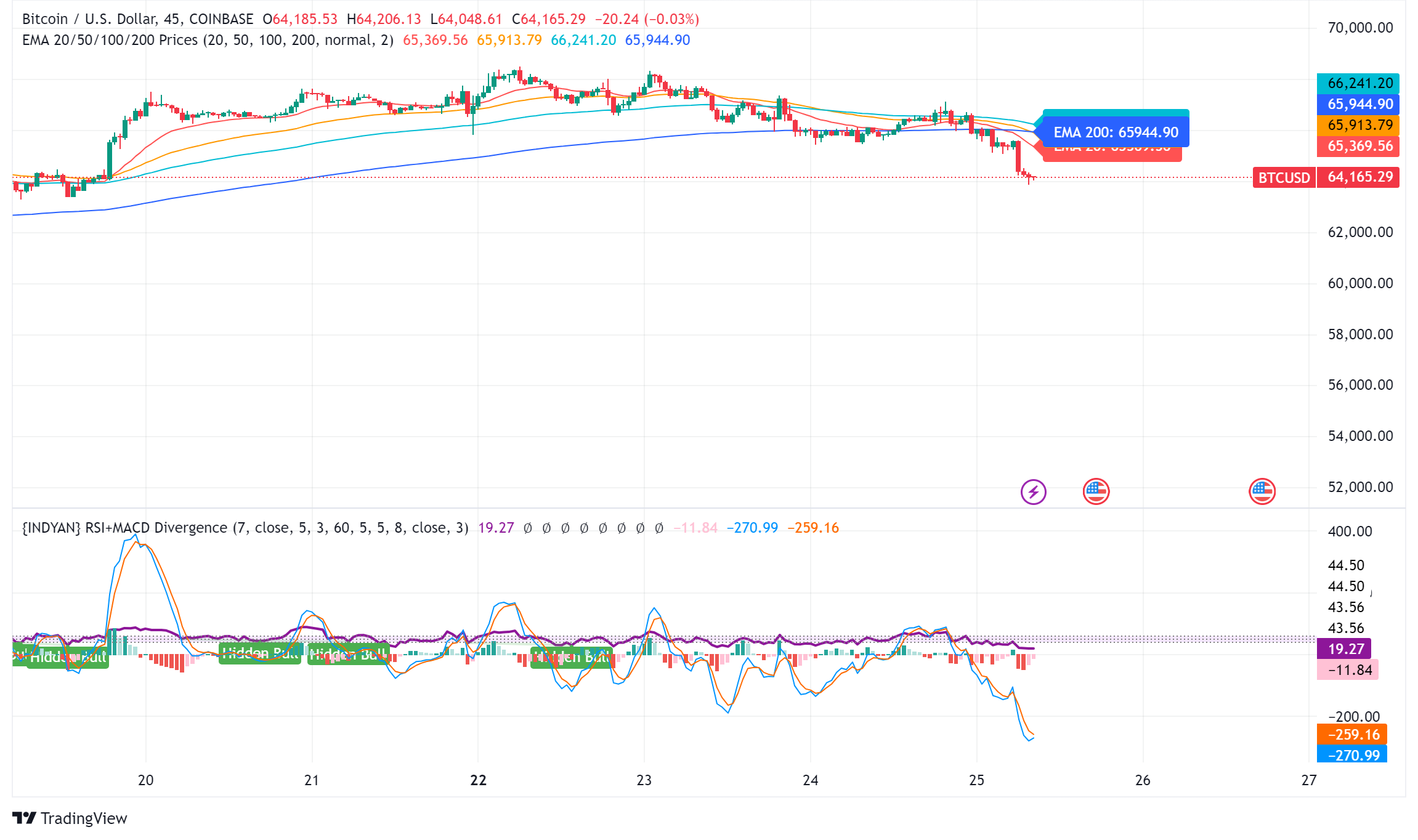
The world’s largest cryptocurrency, Bitcoin (BTC), suffered a significant price decline on Wednesday, falling below $65,000. The decline coincides with a broader market sell-off that has hit technology stocks hard.
Cryptocurrency Liquidations Hit Hard
CoinGlass data reveals a surge in long liquidations in the cryptocurrency market over the past 24 hours. These liquidations, totaling $220.7 million, represent forced selling of positions that had bet on price increases. Bitcoin itself accounted for $14.8 million in long liquidations.
Ethereum leads the decline
Ethereal (ETH), the second-largest cryptocurrency, has seen a steeper decline than Bitcoin, falling nearly 8% to trade around $3,177. This decline mirrors Bitcoin’s price action, suggesting a broader market correction.
Cryptocurrency market crash mirrors tech sector crash
The cryptocurrency market decline appears to be linked to the significant losses seen in the U.S. stock market on Wednesday. Stock market listing The index, heavily weighted toward technology stocks, posted its sharpest decline since October 2022, falling 3.65%.
Analysts cite multiple factors
Several factors may have contributed to the cryptocurrency market crash:
- Tech earnings are underwhelming: Earnings reports from tech giants like Alphabet are disappointing (Google(the parent company of), on Tuesday, triggered a sell-off in technology stocks with higher-than-expected capital expenditures that could have repercussions on the cryptocurrency market.
- Changing Political Landscape: The potential impact of the upcoming US elections and changes in Washington’s policy stance towards cryptocurrencies could influence investor sentiment.
- Ethereal ETF Hopes on the line: While bullish sentiment around a potential U.S. Ethereum ETF initially boosted the market, delays or rejections could dampen enthusiasm.
Analysts’ opinions differ
Despite the short-term losses, some analysts remain optimistic about Bitcoin’s long-term prospects. Singapore-based cryptocurrency trading firm QCP Capital believes Bitcoin could follow a similar trajectory to its post-ETF launch all-time high, with Ethereum potentially converging with its previous highs on sustained institutional interest.
Rich Dad Poor Dad Author’s Prediction
Robert Kiyosaki, author of the best-selling Rich Dad Poor Dad, predicts a potential surge in the price of Bitcoin if Donald Trump is re-elected as US president. He predicts a surge to $105,000 per coin by August 2025, fueled by a weaker dollar that is set to boost US exports.
BTC/USD Technical Outlook
Bitcoin price is currently trading below key support levels, including the $65,500 level and the 100 hourly moving average. A break below the $64,000 level could lead to further declines towards the $63,200 support zone. However, a recovery above the $65,500 level could trigger another increase in the coming sessions.
-

 Videos4 weeks ago
Videos4 weeks agoAbsolutely massive: the next higher Bitcoin leg will shatter all expectations – Tom Lee
-

 News12 months ago
News12 months agoVolta Finance Limited – Director/PDMR Shareholding
-

 News12 months ago
News12 months agoModiv Industrial to release Q2 2024 financial results on August 6
-

 News12 months ago
News12 months agoApple to report third-quarter earnings as Wall Street eyes China sales
-

 News12 months ago
News12 months agoNumber of Americans filing for unemployment benefits hits highest level in a year
-

 News1 year ago
News1 year agoInventiva reports 2024 First Quarter Financial Information¹ and provides a corporate update
-

 News1 year ago
News1 year agoLeeds hospitals trust says finances are “critical” amid £110m deficit
-

 DeFi1 year ago
DeFi1 year ago🏴☠️ Pump.Fun operated by Insider Exploit
-

 Markets1 year ago
Markets1 year agoWhale Investments in Bitcoin Hit $100 Billion in 2024, Fueling Insane Investor Optimism ⋆ ZyCrypto
-

 Videos1 year ago
Videos1 year ago$1,000,000 worth of BTC in 2025! Get ready for an UNPRECEDENTED PRICE EXPLOSION – Jack Mallers
-

 Videos1 year ago
Videos1 year agoABSOLUTELY HUGE: Bitcoin is poised for unabated exponential growth – Mark Yusko and Willy Woo
-

 Tech1 year ago
Tech1 year agoBlockDAG ⭐⭐⭐⭐⭐ Review: Is It the Next Big Thing in Cryptocurrency? 5 questions answered












